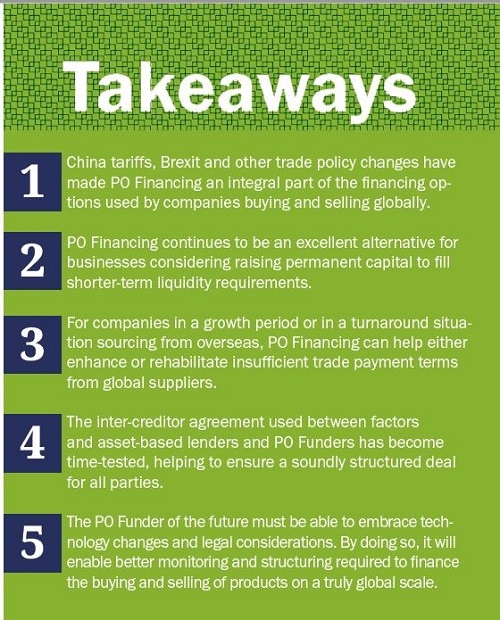- Quasar Capital Welcomes Rob Hydeman as President of Business Credit
- PKF O’Connor Davies Expands Advisory Service Offerings with PKF Clear Thinking Integration
- Encina Private Credit Growth Continues, Hires Matt Giamalis as Senior Vice President of Originations
- Legacy Corporate Lending Appoints Dillon Lounsbury as Senior Vice President of Originations
- Moritt Hock & Hamroff Continues Its Florida Growth By Adding Two New Attorneys
Purchase Order Financing: Then, Now and What’s Ahead
By Paul D. Schuldiner
Purchase order financing has been around nearly as long as its close relatives (factoring) and distant ones (merchant banking) but has become much more prevalent in the last decade. With better technology and other innovations accelerating manufacturing and production timelines to meet demand from e-commerce and big box customers, the global supply chain has never been under more stress. We see this with the China tariffs, Brexit and other significant changes to trade policy. Purchase order financing has never been a more valuable option for companies buying and selling around the globe.
The Evolution of Modern Day Purchase Order Financing
In the 1990s, purchase order financing gained relevance as consumer product companies began to shift domestic production to overseas sourcing and manufacturing in an effort to cut costs. When that happened, many factors were unwilling to give credit in a company’s borrowing base for letters of credit, even if those letters of credit were critical for companies attempting to source from overseas. For most factors, purchase order financing was initially too risky because they did not understand the nuances of international trade or the process of managing the logistics of inventory and meeting delivery times on overseas shipments. Some even worried that suppliers would ship low-quality or imitation products. Or worse, what if suppliers shipped rocks in the containers instead of apparel? Factors were more accustomed to lending against products they could see or touch, not products on the water.
Seasonality issues also posed challenges for lenders. As single-season businesses like outerwear or swimwear companies began to grow, their financing needs changed, making it even more complicated for factors to support them. But the emergence of big box retailers was perhaps the biggest game changer of all. Small and middle-market importers now had a new sales channel to grow their businesses, though for many of those companies, it was both a blessing and a curse. Importers were inundated with large sales orders during their busiest seasons, like Back-to-School, Black Friday and Christmas. This strained cash flow and tied up working capital for longer periods of time.
As time went on, the production cycle for buying and manufacturing products overseas – once as long as 120 days from order to delivery – was cut shorter. Retailers had no desire to hold inventory for long periods of time, which gave way to inventory management issues and a growing reliance on replenishment programs when selling into retailers. Furthermore, inventory financing to grow e-commerce companies and bridge the divide between brick-and-mortar sales and direct-to-consumer distribution makes it more critical than ever to implement multiple inventory financing solutions. The confluence of all of these factors has led to the evolution of the product we know today as purchase order financing.
Entrepreneurial or bridge lenders recognized a gap in the industry early on and saw that purchase order financing could be an alternative for businesses raising more permanent capital. Most lenders preferred companies with stronger balance sheets, but their borrowers were rarely looking for funders that would become permanent equity partners.
Production financing – or work-in-process financing – also became a much-needed financing tool. A form of cash-flow financing for the creation of finished goods, production financing funds raw materials, components and direct labor costs. Though more challenging to underwrite, it became an option for companies manufacturing in the government contracting space, light assembly businesses and other sectors that export under contracts or are supported by letters of credit from foreign customers.
Intercreditor Agreements: The Key to Effective Collaboration
Intercreditor agreements were always the major obstacle in closing a purchase order financing deal. For starters, as purchase order financing started to be utilized more frequently, there was a good deal of unfamiliarity – even concern – that the purchase order funder was usurping the senior lender’s collateral position. This, of course, was never true, as funders were only asking the senior lender to subordinate on the purchase orders and the collateral that would be created through the purchase order financing, nothing more. Purchase order funders typically prefer senior lenders to advance on the receivables in order to pay off the financing, and then the funder subordinates the security interest back to the senior lender upon receipt of the advance on the newly created accounts receivable.
As these tandem deals have gained popularity, the intercreditor agreement has become a more widely accepted and effective tool. Unlike an intercreditor agreement used in the second lien lending market, one that’s used in purchase order financing is transaction-driven, with a clear start and finish. It’s beneficial for the factor or other senior lender to recommend purchase order financing in lieu of providing the over advances themselves, as lenders are always looking to reduce inventory reliance in the borrowing base structure.
Furthermore, for the borrower, relying on a form of transaction capital like purchase order financing is often a more favorable alternative to giving up equity.
Factors and traditional lenders now happily co-exist with purchase order funders, and the intercreditor agreement is the critical component to any soundly structured deal. Without it, a purchase order financing deal simply would not work for all parties.

The Growing Impact of International Trade on Financing
The international trade environment is at a crossroads. The United States is engaged in a seemingly never-ending tug of war with China and the end is not necessarily in sight. Over the last several years, the credit and banking environment in China has become so leveraged that Chinese manufacturers require pre-payments or large deposits in place of letters of credit, which had previously been widely accepted. With a pre-payment, suppliers are paid before goods are even shipped or delivered. The risk of non-performance by the Chinese factory is too great for many funders to bear and they don’t typically prefer the idea of sending cash before there is assurance of production and delivery of finished products.
The increasing reliance on pre-payments, coupled with the threat of tariffs, has created a burdensome liquidity challenge for companies importing overseas products. As a result, ownership and management teams are diversifying sourcing, looking to Vietnam, Bangladesh and other alternative markets. Likewise, letters of credit have been on the rise again in those countries, especially as importers rely on them as part of redeploying sourcing outside of China. For companies unable to reduce their reliance on Chinese suppliers, purchase order funders have stepped in to also provide funding for logistics, freight, and duty, as well as funding “cash against documents” for inventory in transit when letters of credit may not be necessary. Companies in a growth period and companies in a turnaround situation that are sourcing from overseas are also relying more on purchase order financing to rehabilitate insufficient trade payment terms from global suppliers.
The Future of Purchase Order Financing
Despite the ongoing challenges with China and the looming threat of tariffs, international trade will continue to thrive, albeit within a new framework. The rise of smart technology and innovations like blockchain will help to streamline and monitor transactions in real time, potentially making those transactions more secure and provide more transparency and real-time data to purchase order funders and anyone lending on international trade deals.
There are two recent trends in financing products that bear mentioning. The first is what is known as supply chain financing. Even though the two terms are often used interchangeably, supply chain financing and purchase order financing are not one and the same. Supply chain financing, which has shown significant growth of late, relates more to offering a buyer extended payment terms, but may also provide suppliers with an early payment option. Usually this means that goods have been delivered or services have been rendered. Given that purchase order financing addresses the need for pre-shipment finance between a buyer and a supplier, it can be an integral part of the overall supply chain finance needs of a business that trades globally.
A second notable trend is the tendency of certain lenders to act like trading companies, providing unsecured inventory financing as an alternative to purchase order financing. While these programs are intriguing, they usually require the lender to underwrite the borrower itself, which may limit the ability of a small- to lower-middle market business to take on larger orders, beyond what the company’s balance sheet can support.
Companies are always on the hunt for the highest quality and lowest costs in manufacturing and they will travel far and wide to find it. If they haven’t already, businesses that import or export will soon discover there is a whole world outside of China.
Purchase order funders will need to understand and adapt to the various legal issues related to collateral control, logistics, title transfer, foreign duties (including VATs) and other issues related to cross-border trade, and they must get comfortable lending to foreign borrowers. The purchase order funder of the future must truly be global – able and willing to finance a company based in London, sourcing product from Bangladesh and selling to retailers in Japan.
As businesses become more sophisticated and their financing needs become more complex, there is an enormous opportunity for lenders of all stripes. Partnering with a purchase order funder that is highly experienced navigating international trade issues as well as domestic manufacturing is critical for factors, asset-based lenders and other traditional lenders. But aligning with a purchase order funder that can think and react globally will be the real key to remaining competitive in the future.

